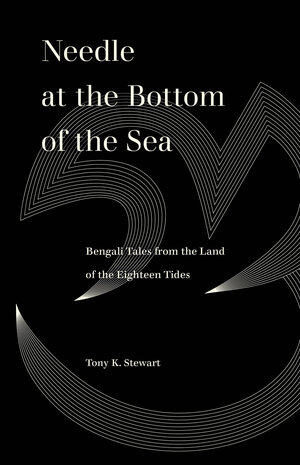
The Bengali stories in this collection are first and foremost tales of survival. Each story in Needle at the Bottom of the Sea underscores the need for people to work together—not just to overcome the challenges of living in the Sundarban swamps of Bengal, but also to ease hostilities born of social differences in religion, caste, and economic class. Translated by award-winning scholar of early modern Bengali literature Tony K. Stewart, Needle at the Bottom of the Sea brims with fantasy and excitement. Sufi protagonists travel through a world of wonder where tigers talk and men magically grow into giants, a Hindu princess falls in love with a Muslim holy man, and goddesses rub shoulders with kings and merchants. Across religion, class, and gender, what binds these fabulous stories together is the characters’ pursuit of living honorably and morally in a difficult, corrupt world.
Tony K. Stewart is Gertrude Conaway Vanderbilt Chair in Humanities, Emeritus, at Vanderbilt University and a specialist in the early modern literatures of the Bengali-speaking world. His most recent work is Witness to Marvels: Sufism and Literary Imagination, winner of the 2021 Ananda Kentish Coomaraswamy Book Prize from the Association for Asian Studies.
What motivated you to work on an English translation of this work, in particular?
When I was investigating the Bengali and Sanskrit hagiographies of the Hindu god-man Krsna Caitanya (1486-1533), I kept bumping into a mysterious figure named Satya Pir, who was identified as a Muslim pir and the Hindu god Narayan or Krsna. Despite finding more than 800 hand-written manuscripts and 150 printed texts by more than one hundred authors telling Satya Pir’s tales, there was virtually no mention of this figure in the literary and religious histories of Bengal. From this serendipitous start, I eventually discovered that the Satya Pir tales were part of a larger literature that told the stories of the fictional figures featured in this volume. I say fictional because Muslims generally do not acknowledge the category of myth in telling their tales, yet none of these central figures—Satya Pir, Daksin Ray, Gaji Pir, Manik Pir, Bonbibi, Kwaja Khijir—can be found in any of the Persian chronicles or court records in Bengal. They are quite distinct from the historical Sufi saints, yet as popular as their stories were, they were effectively invisible to anyone except their followers. I felt their stories needed to be shared.
Why do we need this translation? What does it add to our understanding of South Asian culture and literature?
None of the five stories has been translated into English before, though the story of Musa (Moses) and Kwaja Khizir that I co-translated with Ayesha Irani is Quranic in origin and circulates in a number of other languages. These tales are some of the most popular ones from Bengali Muslim communities over the last four centuries, especially in the Sundarban delta of Bangladesh and West Bengal, India. Today Bonbibi, a Sufi heroine, is considered the protector of all who live in the Sundarban’s mangrove swamps, the Atharobhati, the low-lying lands of the eighteen tides. Muslims, Hindus, and indigenous tribals alike pay homage to her and her cohort, Shah Jangali, Gaji Pir, and Daksin Ray, as protection against tigers as they enter the forest to harvest honey, wax, salt, and timber. For the last six centuries, these stories have illustrated the need for tolerance and cooperation to survive the harsh landscape. They argue that penury makes it difficult to live an ethically sound life, so Bonbibi, Gaji Pir, and Daksin Ray provide for those who are devoted to them, often performing miraculous feats to save their devotees or drive home a point to those who resist. But the stories also tell of predicaments familiar to all humans — with often novel solutions.
How would you describe the style of the work?
The stories are unabridged translations in prose and free verse. They are not retellings, like the wonderful version of Bonbibi’s story told in tantalizing vignettes by Amitav Ghosh in The Hungry Tide. I have been actively translating early modern Bangla for more than forty years and I have tried to convey just how vibrant and sophisticated these stories are, despite being characterized as folk tales.
In much the same manner as the marvelous tales of Arabian Nights or the epic Mahabharata and Ramayana, these tales describe human predicaments and how to navigate seemingly intractable social conflicts. They entertain and teach, but do not articulate theologies or promote prescriptive practices. Instead, they convey their truths through story, in simple parables or in more sophisticated allegorical passages, focused on the nature of human and divine love and how to tame hubris and anger. The figures transform into white flies, shapeshift into giants, command armies of tigers and equally matched armies of crocodiles, often resulting in incredibly humorous exchanges. The tigers especially provide comic relief as they complain endlessly about their ailments, their broken teeth, and all the other maladies that assail those who grow old. But in that process, these tales subtly introduce and naturalize a Muslim perspective into the traditionally Indic culture of Bengal, while also writing Bengal into the larger literary world of Islam.
What was the translation process like? What factors did you keep in mind as you were translating the work?
I wanted to capture the full sophistication of narrative expression while omitting nothing. Historically, many translators have chosen to —or been pressured into — editing these old texts for western readers and have eliminated repetitions or digressions. I retained those passages because I trust that the author knew best, and because they convey something of the oral flavor of their composition.
I have glossed every term within the translation itself so that readers do not need to consult the glossary to appreciate the detail and nuance, though there will be the occasional footnote to clarify obscure expressions. The language of these tales is still very much in transition as it incorporates Perso-Arabic elements while reflecting the scribal inconsistencies typical of the period. For example, spellings will not be standardized, but should be obvious, with all variants of a name or term clearly indicated. Finally, I have included information on the flora and fauna, which often gives insight into the author’s choices, as well as technical terminology on the construction of the wooden boats that feature in these tales.
Can you tell us about one of your favorite stories or scenes from the book?
In the first story, the seventeenth century Ray Mangal of Krsnaram Das, the Hindu godling Daksin Ray and the Sufi Gaji Pir are in conflict over an inadvertent insult—not over religious differences. At the climax of the fight and at the exact same moment, each slays the other. God, in the form of Satya Pir—carrying a Bhagavata Purana in one hand and a Koran in the other—intervenes, chiding them for their childish behavior. Satya Pir then turns to the lead tiger and warns him that soon, human activity in the Sundarban will lay waste the mangrove swamps and make it difficult for any of the tigers to feed their young. It was a prescient prediction of the impending destruction wrought by the Anthropocene—but delivered four centuries ago.
What is the main thing you hope readers will take away from the book?
These stories make clear that not all conflict between Muslims and Hindus is religious in origin. Characters on both sides of that divide, which today seems unbreachable, share a common humanity, and the reader should revel in their imaginative nature.
